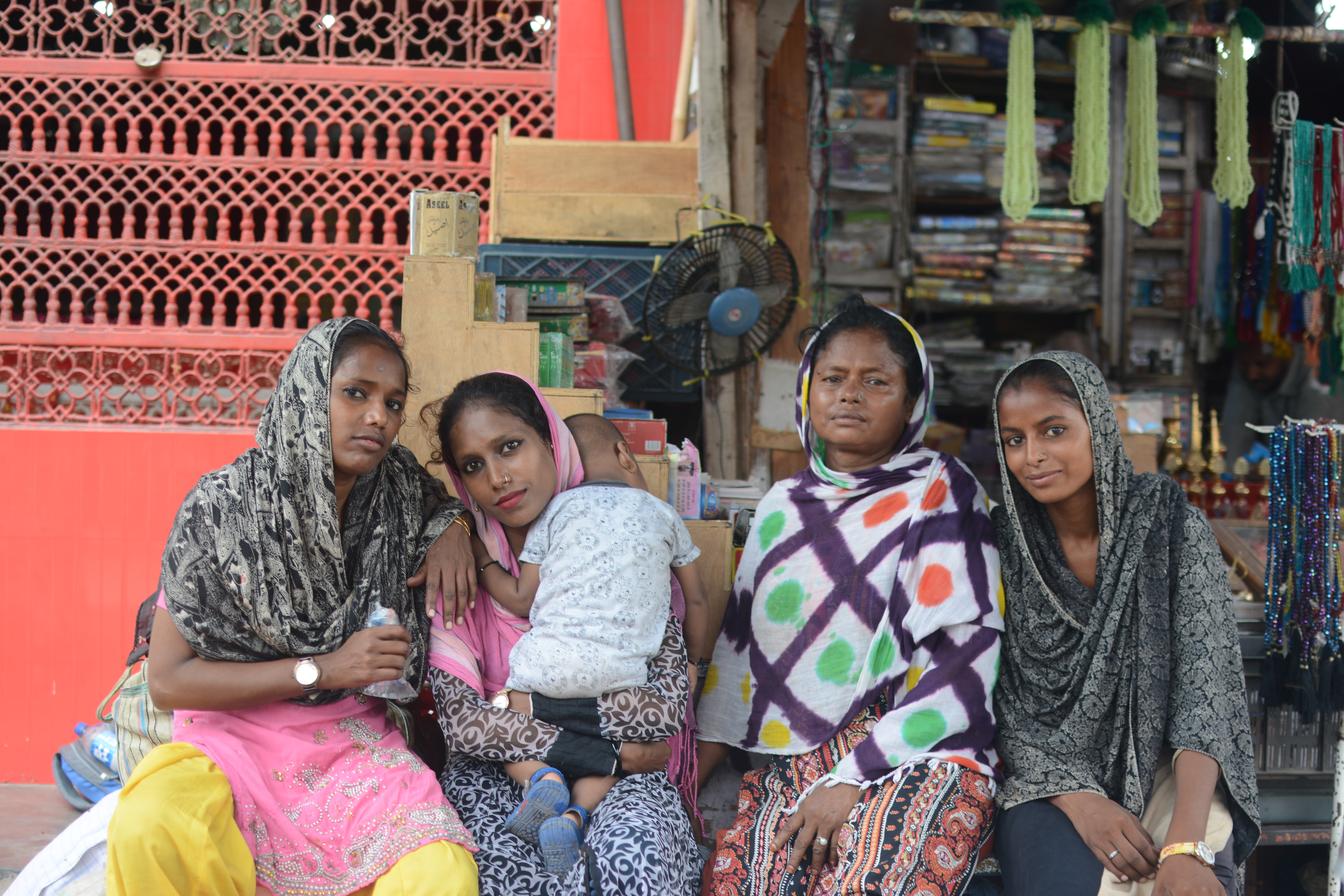Very few women from Chandni Chowk can be seen in public spaces, unaccompanied by men. But some of them have broken the shackles to find work and even to go for Haj to Saudi Arabia
Chandni Chowk is in shambles, and yet it continues to be as vibrant a shopping centre as ever. Civic works, traffic congestion, roads closed, dust flying — and inside tiny shops, the sparkle of wedding garments and jewellery.
Amina, 23, stands in one of these shops, with a place right in the front which is for beginners, the newly employed. She makes less money than the other more experienced hands — Rs 9,000 per month and no entitlement to bonus. One day, she will be ‘promoted’ to a position beside the young women behind the counters displaying the more expensive jewellery.
Amina does not think her plight is pitiable. In fact, what she has achieved at such a young age is more than what she would have imagined three years before leaving Bareilly with her mother and siblings.
With her education having been stopped from going beyond 10th grade, her prospects, she says, were not great. “Else I would not have been here. I too would have been in an office with a good job. But I dropped out of school, stayed at home out of fear of our father”.
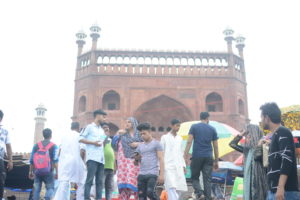
Her father’s autocratic, abusive behaviour was the reason that eventually pushed her mother and siblings to relocate. “My father would hit my mother a lot and didn’t allow us to go anywhere”, she says.
Finally, they decided they had had enough and with the help of their aunt, came to Delhi on Republic Day three years ago, their entire belongings packed into four bags. They had heard a lot about Delhi, the city which offers escape from conservatism and poverty to people from backward areas.
The move proved to be a good one. One by one, every member of the family found odd jobs to do. At first, Amina stitched clothes and made slippers. “When Papa came over, we told him that now you need us and we don’t need you. If you want to stay, stop dictating terms on us. Or go back to Bareilly”.
And the rest is history, as she smiles and whispers: “He stays with us… very peacefully”.
India has made slow progress in doing away with age-old patriarchy which embeds itself in all streams of life. Be it from the ubiquitous mindset of males being the heads of the family or the subtle ways of justifying why women should not step outside the threshold of their houses without their male ‘minders’.
While this could be a practice of any household in the country, we focus on the Muslim community which constitutes 33.36% of the Central District of the city — according to the 2011 census — under which Old Delhi falls. The reason is to shine some light on the women here and also on the concept of Mahram, in a time where women are trying to break the shackles of male domination.
Looking for help
One woman who has a finger on the pulse of Chandni Chowk women’s personal struggles is middle-aged Farzana Saifi, who works for the government’s women’s cell. She lives near Delhi Gate and has helped women fighting cases of dowry, domestic abuse and other family disputes. “Most women like to come to our cell first. We want that too because if a problem can be resolved with dialogue, without bringing in the police, then it’s better,” Saifi tells us.
One of their recent success stories was about reinstating a woman to the marital home she was kicked out of by her husband. “He had brought home a second wife and asked his first to leave with their children. We went to speak to him…he didn’t want any trouble. Now they all stay together and everything is fine”, she says.
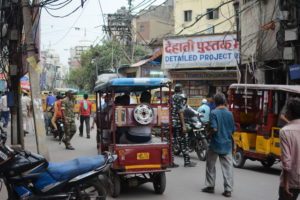
The fact that women seek help from a non-profit instead of hiding their struggles under a cloak of shame, she tells us, is a positive sign. “They still have a long way to go but it’s easier for them to talk to a stranger. Times are changing and they do seek counselling.”
She points to a bigger problem, which is that education does not equip girls with the courage or the skills to join the workforce. “Why is it that the education is just about kitchen work?” she asks, “Even if they are being educated in school, they don’t end up getting proper jobs. Instead, they just get married and stay at home”, Saifi adds with a tinge of irritation.
She gives the example of her daughter who is a graduate. “I would keep telling her to go out and do something with her life but she would hesitate…”. Her daughter then married in 2008 and then took another five years to finally being convinced to use her degree and start teaching.
She herself was married off at the age of 13, but could continue her studies till 12th grade, when she had her first child.
We met many women in our quest to learn about the women living in Old Delhi. Most who did agree to speak to us had not been educated beyond 8th grade — which seemed to be a standard response.
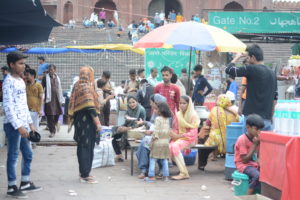
While not the lowest in Delhi, the female literacy rate in Central District under which Old Delhi falls is 82.49%; male literacy rate is 87.50%. The sex ratio in fact is the highest amongst the nine districts listed in the 2011 census at 892 per 1,000.
But the Centre’s report ‘Women and Men in India (A Statistical Compilation of Gender Related Indicators in India) 2018’ shows religion-wise sex ratio among major States/UTs, pointing to Muslims in Delhi with the lowest at 855 per 1,000 followed by Hindus at 865.
Going on to the female labour workforce, a report published by the Delhi government titled ‘Statistical Bulletin on Work and Livelihood: A Glimpse of Delhi’ reveals that district-wise worker numbers in the 2011 Census showed Central district having 10.8% working women compared to 57.7% males.
A journey far, far away
Saifi, along with working with the women’s cell in her region, has also been helping people go for Haj pilgrimage to Saudi Arabia for the past 23 years but hasn’t been able to go herself. “I keep telling my sons to take me but they say give it a few more years. My husband passed away a few years back so I didn’t have anyone to go with”, she explains.
The Haj pilgrimage, which happens once a year, is considered mandatory for every Muslim once in a lifetime. But women from India were not allowed to go to Saudi Arabia’s Haj without a Mahram — a male blood relative or one related through marriage — until the rules changed in 2018.
This year is the first time the government of India’s move to eliminate such a rule saw its fruition but just 11 women went from Delhi without a man by their side. The Delhi Haj Committee situated at Haj Manzil shared details of women who went to Mecca — the eldest being two 71-year olds.
The chairman of the committee and Aam Aadmi Party MLA Asim Ahmed Khan says that the lower turnout is because many women don’t know about this change of rules. He said earlier women “would be ashamed to go by themselves or with an unrelated man”, but now with the committee working to spread the word, they hope to make the total 200-300 by 2020.
Mehrunisa, who works with an NGO called Jal Kalyan Mahila Samiti, says that lack of publicity is not the reason behind the low turnout but because “women think that this is against the Quran…why else would there be so few going for this”? she asks.
Sitting in Khan’s office to implore him to finish pending work in her area, along with a healthy dose of banter, Mehrunisa spoke a little more with us on why she thought women should not “disobey” this rule. “Mahram is an obligation for the woman when they step out of her home. And while this rule is not followed here in Delhi, at least for the house of God women can follow it”.
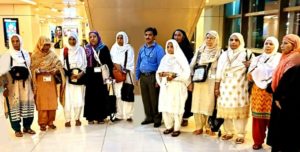
A few younger women and men we met had come to drop their two elderly relatives (a married couple) as they embarked upon their journey to Haj. They were too shy to respond whether this rule change was something they would take advantage of. Instead, the older woman expressed her disdain for the new rule.
The loosening of the rules, though, is just applicable to women above 45, Khan says. This is because, he puts it: “When there are 1 crore men in attendance, an 18 or 19-year-old would not be secure. And anyway, they wouldn’t want to go by themselves”.
The women who are booked to go are travelling in groups. Of the 21 Haj embarkation points in India, Delhi is the largest: It saw 23,000 people leave from Delhi last year.
Executive Officer of the Committee Ashfaque Ahmed Arfi says that most of the women applicants under “no Mahram” are from Southern states of India. This he says is because they are more educated, and are in general more confident of their surroundings.
Long journey to safety
As a whole, however, menfolk of Old Delhi prefer the women in their families to stay confined to their homes. When a communal incident in end-June brought the Old Delhi region of Chawri Bazaar to a halt, women were the first to feel the brunt.
Tabassum Naaz, who lives close to the area, told Patriot: “When any incident takes place, even if it’s just rumour-mongering, men become unduly protective. Diktats are issued that nobody should leave the house.”
Fear of the wicked world outside, however, is not just limited to such times. It is a year-long mission, one which is so engrained in the psyche that women themselves feel it wrong to step out.
In the grounds of Jama Masjid, less than 4 km from Delhi Gate, where the entire area is usually bustling with activity — people eating kebabs, buying little knick-knacks and roaming barefoot at the Jama Masjid enjoying the breeze in a tepid, humid day — you can see few women without their Mahram.
But in a nearby lane of Meena Bazar, where open roadside stalls of clothes, toys, watches, bags lie in wait for a customer, we find Shehnaz wearing a head scarf, who leads us to her sisters and mother sitting by a silverware stall.
The children have spent their entire lives here.
Manju Khatoon, a Hindu by birth, got married to a Muslim back in Bihar. However, five children later, he married a second time and the marriage broke down. Unwilling to accept this situation, she left him and came to Delhi, taking the children with her.
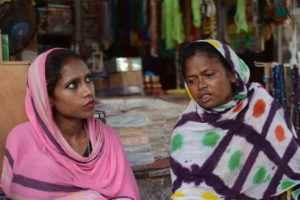
One of those five kids was Shehnaz. Naseema, the eldest, now 26 years old, has her own three children. She recalls her mother’s struggles. They first camped near the railway tracks and “She begged so we could eat”. Now Khatoon sits with her new smartphone that her eldest gifted to her on her birthday.
“My mother does not know how to write, except for her name. But she can use a smartphone”, she proudly tells us.
Naseema was married at the age of 18. The shop they work at helps them make Rs 100-150 a day. She says it’s better than staying at home and getting mixed up in trouble.
She also got a job at a bank a month ago. With a little formal education till 8th grade, she managed to secure the job which entails her going to the Sahara Bank in Daryaganj twice a week to fill up forms and to work at the counter for opening new bank accounts.
“After marriage I thought, how long will I live off a man’s earnings? Only the house is run with my husband’s money. For other things it would be good if I worked as well.”
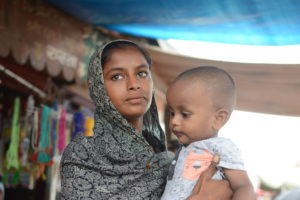
These streets have given her and her family a refuge. She speaks about her childhood, even as she feeds her baby, and tells us that the bazaar was a bustling space where she, her siblings and friends all played, but “now things are different”.
“All my friends have gotten married and left. Unlike my husband who does not control me, theirs do and don’t allow them to go out unescorted. They are only allowed to go visit their mother’s home and close relatives”.
These are old practices of another age, she says. Rightly so, for though some still are governed by these old ways, others like Khatoon and her family, Yamina and Saifi, have chartered their own paths.

